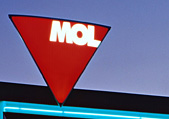
Hungary’s MOL Driving Efforts to Interconnect Gas Markets
Publication: Eurasia Daily Monitor Volume: 6 Issue: 44
By:

On March 3 the Hungarian gas transmission operator FGSZ—a subsidiary of MOL, the Hungarian oil and gas company—signed a contract with Croatia’s state pipeline operator Plinacro to build an interconnector gas pipeline between the two countries. The project fits within MOL’s strategy of promoting construction of interconnector pipelines between countries of Central and Southeastern Europe, a trademark MOL concept. The European Commission has hailed this concept for advancing EU-wide policy objectives; but the wealthy EU countries are proving avaricious and short-sighted with the financing of such projects in the new member countries.
Originally announced in December 2007 as the New Europe Transmission Systems (NETS), MOL’s concept showed an early success with the agreement to connect the Hungarian and Romanian systems through the Szeged-Arad pipeline. This joint project of FGSZ and Romania’s Transgaz is due for completion in 2010. MOL and Transgaz are also parties to the Nabucco consortium for transport of Caspian gas to Europe.
The privately-owned MOL does not propose to change the state ownership and management of pipelines in the other countries. The goals are to unify small national markets into a large, region-wide market, attractive for Caspian and Middle Eastern gas producers and suppliers; to open access into such a unified market from multiple directions—both for pipeline-delivered gas and LNG—thus removing the monopoly that Gazprom has long had in national markets while enabling countries in this region to trade gas among themselves at all times, whether on a regular basis or in emergencies when one or more countries are hit by supply cuts. Russia’s recent suspension of gas supplies via Ukraine to Europe dramatized the need to build interconnector pipelines for alternative supplies and emergency sharing of stored gas.
The pipeline from Varosfold in Hungary to Slobodnica in Croatia will run almost 300 kilometers (185 miles)—210 kilometers (130 miles) on Hungarian territory and 88 kilometers (55 miles) on Croat territory—and is to be completed by the end of 2010. It is designed as a high-pressure pipeline, with two compressor stations for a throughput capacity of 6.5 billion cubic meters per year from 2011 onward. Investment costs are estimated at €400 million ($506 million). Each side is responsible for construction work and financing on its own territory, with approximately 75 percent of the costs falling on the Hungarian side and 25 percent on the Croatian side (MTI, March 3; Vilaggazdasag, www.business.hr, March 3, 4).
Meanwhile, from a multibillion Euro financing package for energy projects and anti-crisis stimulus measures, the European Commission has pledged to contribute a paltry €20 million ($25 million) to the Hungary-Croatia interconnector and an equal sum to the Hungary-Romania interconnector. The EC’s overall package is weighted heavily in favor of West European countries to the detriment of the EU’s new member countries, although the energy security challenges confront mainly the latter group, not the former.
The Hungary-Croatia link will be capable of operating in both directions. This means that Croatia, and potentially some of its neighbors, could be linked to the Nabucco pipeline via Hungary and trade gas with the Nabucco participant countries, once that project comes to fruition. Conversely—and of considerable strategic significance—several countries in Central and Southeastern Europe will gain access to gas supplies from Croatia’s LNG project through the Croatia-Hungary and Hungary-Romania pipelines and other planned links among the region’s countries.
The LNG terminal on Croatia’s Adriatic coast is expected to see the start of construction work this year and to come on stream in 2013. The participants in the project include Total of France, Austria’s OMV, the German companies RWE and E.ON Ruhrgas, Croatia’s state pipeline company Plinacro, and the Croatian oil company INA. The Hungarian MOL recently acquired a dominant 47 percent stake in INA as well as the operating rights and will thus be involved in the LNG project as well (Vecernji List, February 25; Vjesnik, March 4).
The NETS concept, generally, and its component pipeline links are significant enablers to the Nabucco project and also for LNG import projects. A unified regional market—with a large aggregate demand, a homogenized regulatory system, and flexibility of gas transmission within the region—is far more attractive to gas suppliers and international investors in the infrastructure than the existing patchwork of relatively small national markets in this region. Market segmentation is a legacy of the Soviet era in Central-Eastern Europe. It remains a major obstacle to these countries’ goals of supply diversification, energy security, and infrastructure modernization.
The Hungary-Croatia and Hungary-Romania pipeline links will create a unified gas market from the Adriatic to the Black Sea by 2010, with much applause but little funding from the EU. To advance the regional interconnection further, however, the EU will have to support the North-South interconnection, Poland-Slovakia and Slovakia-Hungary. The EU Commission has itself declared that north-south pipeline links are urgently needed in a region that has only inherited east-west pipelines from the Soviet era. The Russia-Ukraine gas crisis in January demonstrated yet again the dangers inherent in this situation for EU member countries.




